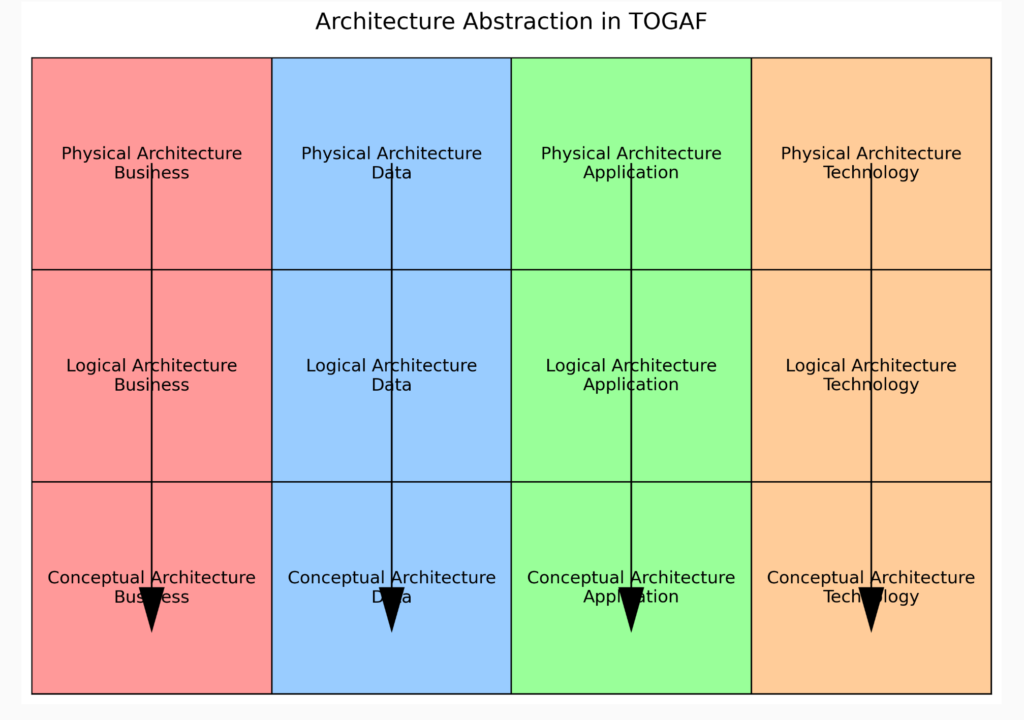-
Architecture Abstraction in Enterprise Architecture
- Posted on: June 2, 2025
- by: Anand Pandey
- 0 Comments
In the world of enterprise architecture, managing complexity is a constant challenge. TOGAF (The Open Group Architecture Framework) addresses this by introducing the concept of architecture abstraction—a structured way to view systems at different levels of detail. This approach helps stakeholders—from executives to developers—understand and contribute to the architecture in ways that are meaningful to them.
🧱 What is Architecture Abstraction in TOGAF?
TOGAF promotes the use of three levels of abstraction to describe architecture:
- Conceptual Architecture: High-level view of business goals, capabilities, and stakeholder needs.
- Logical Architecture: Technology-agnostic design of systems, data flows, and application interactions.
- Physical Architecture: Concrete implementation details including platforms, tools, and infrastructure.
Each level builds upon the previous one, ensuring that strategic intent is preserved all the way through to implementation.
🧩 Visualizing Architecture Abstraction
Here’s a clear, high-resolution diagram that illustrates how abstraction levels align with the four architecture domains:

This diagram shows how each abstraction layer—Conceptual, Logical, and Physical—spans across the Business, Data, Application, and Technology domains, creating a cohesive and scalable architecture.
✅ Real-World Example 1: Smart City Traffic Management System
🔹 Conceptual Architecture
- Goal: Reduce traffic congestion and improve commuter experience.
- Capabilities: Real-time traffic monitoring, dynamic signal control, commuter alerts.
🔹 Logical Architecture
- Components: Traffic data aggregator, analytics engine, mobile app interface.
- Data Flow: Sensor data → Analytics → Dashboard & Alerts.
🔹 Physical Architecture
- Technologies: IoT sensors, cloud-based analytics (e.g., AWS Lambda), mobile app (iOS/Android), 5G connectivity.
✅ Real-World Example 2: National Digital Health Platform
🔹 Conceptual Architecture
- Goal: Improve healthcare access and patient outcomes.
- Capabilities: Patient records, telemedicine, prescription management.
🔹 Logical Architecture
- Components: EHR system, video consultation module, pharmacy integration.
- Data Flow: Patient data → Doctor interface → Prescription system.
🔹 Physical Architecture
- Technologies: Cloud-hosted EHR (e.g., Azure), secure video conferencing (e.g., WebRTC), encrypted APIs for pharmacies.
🏷 Suggested Tags
- TOGAF
- Enterprise Architecture
- Architecture Abstraction
- Conceptual Architecture
- Logical Architecture
- Physical Architecture
- Smart City
- Digital Health
- IT Strategy
- Architecture Framework
📝 Summary
Architecture abstraction in TOGAF is a foundational concept that enables clarity, collaboration, and scalability. By separating architecture into conceptual, logical, and physical layers, organizations can ensure that strategic intent is preserved from vision to implementation. Whether you’re building a smart city or a national health platform, abstraction is the key to managing complexity and delivering value.
-
TOGAF (The Open Group Architecture Framework) organizes enterprise architecture into four interrelated domains. These domains provide a structured way to analyze, design, and implement systems that align with business goals.
🔍 The Four Architecture Domains (Explained in Detail)
1. Business Architecture
This domain defines:
- The organizational structure
- Business processes
- Capabilities, functions, and roles
- Strategic goals and objectives
It answers:
👉 What does the business do? Who does it? Why does it matter?2. Data Architecture
This domain focuses on:
- Data models (conceptual, logical, physical)
- Data flows and data governance
- Data storage, integration, and security
It answers:
👉 What data is needed? Where is it stored? How is it accessed and secured?3. Application Architecture
This domain defines:
- The software applications used in the enterprise
- Interactions between applications
- Interfaces and integration patterns
It answers:
👉 What applications support the business? How do they interact?4. Technology Architecture
This domain includes:
- Infrastructure (servers, networks, cloud platforms)
- Middleware, operating systems, and technical standards
- Security, performance, and scalability
It answers:
👉 What technology supports the applications and data?
🧠 Real-World Example: Smart City Transportation System
Let’s say a city government is building a Smart Transportation System to reduce traffic congestion and improve commuter experience.
🔹 Business Architecture
- Goal: Reduce average commute time by 20% in 2 years.
- Stakeholders: City planners, commuters, traffic police, public transport authorities.
- Processes: Route planning, traffic monitoring, public transport scheduling.
🔹 Data Architecture
- Data Sources: GPS data from buses, traffic sensors, commuter feedback, weather data.
- Data Models: Real-time traffic flow, historical congestion patterns.
- Governance: Data privacy policies, open data standards for public access.
🔹 Application Architecture
- Apps: Mobile app for commuters, dashboard for traffic control center, APIs for third-party developers.
- Integration: Real-time data feeds from IoT sensors, integration with Google Maps and public transport APIs.
🔹 Technology Architecture
- Infrastructure: Cloud-based platform (e.g., AWS or Azure), 5G connectivity, edge computing for real-time processing.
- Security: End-to-end encryption, role-based access control.
- Scalability: Designed to support millions of data points per day.
🖼 Visual Diagram
Here’s a visual representation of how these domains stack and interact:

📝 Summary
The four architecture domains in TOGAF—Business, Data, Application, and Technology—offer a comprehensive framework for aligning IT with business strategy. Whether you’re building a smart city, modernizing a bank, or transforming healthcare, these domains help ensure that every layer of your enterprise is working in harmony.
Tag